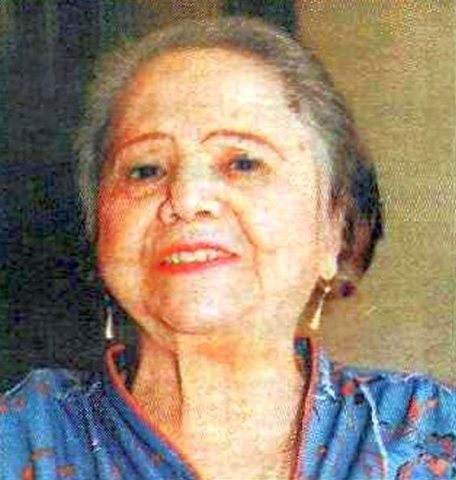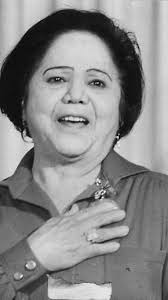
Known to all Costa Ricans as the “Alma Nacional” (National Soul), the cheerful, always flirtatious, deeply Costa Rican and irreplaceable Doña Carmen Granados Soto has been an outstanding folklorist, outstanding composer, humorist, broadcaster, poet, commentator, artist, creator of characters inspired by a deep nationalism and leader of humanitarian causes.
“A multifaceted lady”, as she assures. Thanks to her perseverance, she managed to win the favor of the public, with deep assiduity as one of the virtues with which Carmen Granados Soto conquered the heart of Costa Rica.
She was born in the town of La Merced, in San José on April 26, 1915, daughter of Mr. Manuel Granados López and Mrs. Maria Cristina Soto Pereira. From her adolescence, she had to leave high school to face the responsibility to finish raising her eleven brothers after the death of the parents. As Mrs. Carmen said, “I was the pole that had to hold the tent”.
Artistic career

She began her artistic career from a young age as a popular singer on “Radio Nueva Alma Tica” singing in Spanish the song My Blue Heaven that at that time was a success when it was sung by her brother in English. But her consolidation as a folklore artist is given when playing the role of the peasant in Radio City.
She was a co-founder of the first Radio Theater that was made in Costa Rica and was held at the Nueva Alma Tica station. Together with Ángel Sánchez and Oscar Zamora, one of the programs having the largest audience was called “Los Bobos de la Radio” and in some of the chapters, she worked alongside the much-remembered Rodrigo Sánchez. Within that same space, she worked on “La Niña Pochita” in the role of Leopoldina in which she plays a student and every question of the teacher, always came out with nonsense.
She joined the National Theater Company with Ofelia Quirós, Gordo Ortiz, Alberto Castillo, Carlos Palma, Zaida Quirós, Babby Granados, Pilar Durán, Mario Chacón and other artists of that time.
Her career as an artist was not limited to the national level; on several occasions she took her humor in presentations made in foreign countries such as Panama, Nicaragua, the United States in which she was invited by the Tica Colony in New York and Los Angeles, receiving numerous acknowledgments on those trips.
She worked on “Los Cómicos de la Legua” along with El Gordo Ortiz, Julia Cordero, Leyla Alvarado, the Güera Ester García; in operetta and zarzuela companies with works such as “La Viuda Alegre”, “La Corte del Faraón“, “El Puñao de Rosas“, “Don Juan Tenorio” and in an artistic event, she sang accompanied the remembered Melico Salazar, a pioneer of mass folk art and legendary representative of the humorous peasant Chota.
Work in the Media
Doña Carmen Granados was the creator of several characters on national radio who were impregnated by the mischief of the Costa Rican peasant, characters who dramatized and remind us of the essence of the Tico: “Doña Vina”, “Rafela”, “Prematura”, ” Doña Chona and Tranquilino”, “La Escuela de la Niña Pochita”.
“Rafela” was created in Radio City and there it ran for twelve years, it was the basis for the occurrence of creating other typical characters. Doña Chona and Tranquilino were the characters of the program “El Matrimonio Ideal” that was broadcasted on Radio Para Tí. “Doña Vina” was created on Radio Monumental in a program with Carlos Peña.
She worked on the program “La Corte Suprema del Arte” that was done on Radio San José, located on 10th Avenue, in its mothers sent their children to participate. In the program, the “Voz de la Victor” had Rodrigo Sánchez as a locution partner.
On television, she worked with Chungaleta and Lico Font on a news show called “El Resbalón” in which all the news was a joke. In Theater she participated in “La Duquesa del Bal Tabarín” in the role of “Madame Morel”.
Some phrases in her songs such as “Yo Soy Rafaela El Alma Nacional” will not be forgotten by many generations who had the opportunity to live with Doña Carmen the programs on Radio Columbia, Radio Monumental or Radio Alma Tica.
In her programs and characters, Doña Carmen Granados rescued the so-called “Choteo” characteristic that individualizes the Costa Rican and gave her the typical mischievousness impregnated with the national soul, thus contributing to the formation of the Costa Rican identity.
Musical compositions

With her musical compositions, she paid tribute to great Costa Rican personalities, like boxers (Tuzo Portuguez), footballers (La Selección) and cyclists. She paid tribute to the popular end of year celebrations and to important events in national history which consigned, among others, in the composition of the well-known “Corrido de Pepe Figueres” which she sang from the entrance of the Bellavista Barracks where Mr. José Figueres Ferrer and the revolutionary forces entered San José through Central Avenue. Doña Carmen Granados was the first to sing on Costa Rican radio, a duet with Leila Alvarado, the song “Amor de Temporada” by the composer Héctor Zúñiga.
Her work rescuing the Costa Rican Soul was arduous. In all her phrases she praised the simplicity and vivacity, a little shy of the Costa Rican. The “Costariqueñismo” (nativist expressionism) was her favorite language, through which she managed to exalt the cultural richness of our people, injecting joy to her listeners and returning part of her peasant personality.
With her participation in Radio Theater, she managed to recreate the modest and cheerful life of most Costa Ricans, centered around the family when there was no electricity. Doña Carmen was also a poetess and she put each one of her characters to exclaim and externalize that peasant imbued in the popular culture.
Doña Carmen even made ecological poetry like “No lo hagas” which is a tree that speaks to a lumberjack when he comes to cut it down, and we cannot forget the famous “Guanacasteca” to which Jesus Bonilla put music.

